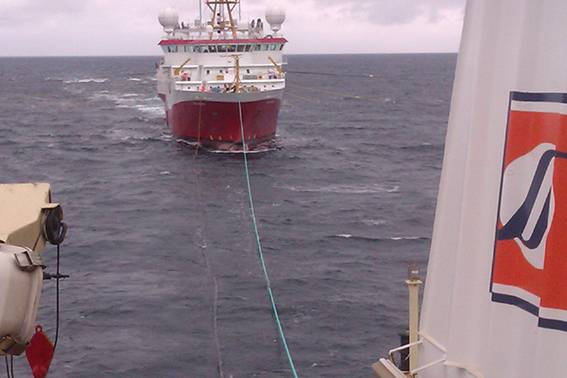
A seismic survey segment which has seen its fortunes slashed heavily since 2015 and which isn’t expected to recover fully for at least another five years is starting to make waves as it navigates a still bumpy road marked by green shoots.
First to feel the pinch when exploration slows, seismic is expected by numbers crunchers to be the last lot to recover. In the long wait for 2013-like profits, the survey industry has seen bankruptcies, near bankruptcies, courtroom battles, unlikely alliances and comebacks. Now, some are finding new assignments and looking at new business streams while also remaining under the gun, as oil-company operators make “adjustments” to keep costs down.
Even a usually gushing Canadian conference organizer in May 2019 describes the current market as “a more stable footing” for an industry which has seen heady days turn to headaches. One odd happening is the sight of former oil company clients getting in on the seismic game and doing their own surveys.
“We’re the best in the world at this,” ConocoPhillips innovation manager, Dave Mabee, is quoted as saying. He was remarking on the company’s technological prowess, especially in inventing its own seismic survey tools for life-of-field.
“With its proprietary compressive seismic imaging technology, ConocoPhillips has saved hundreds of millions of dollars shooting and processing seismic data, both onshore and off,” Mabee said. The company has told its staff that it’s pursuing increasingly complex E&P targets and that means it needs “higher-quality seismic data”.
“But getting higher-quality data historically meant incurring significantly higher cost,” so, ConocoPhillips has developed its own compressive seismic imaging, or CSI, technology that dramatically improves image quality “while reducing costs, speeding up acquisition and reducing health, safety and environmental risk exposure”.
“Since the introduction of CSI, the amount of seismic data collected and processed has increased tenfold,” the company says.
When a supermajor says that, the survey industry notices. From mere graphics generation, CSI ups the game by using algorithms to one-up grid-data collection used to find a reservoir’s anomalous sweet spots.
So, the survey industry has a new, powerful client-rival. How much that’s hurt earnings is to tedious to know, but at least three Norway-based seismic outfits have sort-of flatlined, financially, since 2015.
One that hasn’t, TGS-NOPEC, has, nonetheless seen its share of battles. It’s been arguably quicker than the segment as a whole at finding new ways to earn, and it boasts one of the industry’s largest global databases of digital well logs, regional geophysical and geological products plus vast seismic libraries.
Joining forces
A bright spot in the segment, TGS-NOPEC is seen benefiting from the $1.7 billion key client Equinor intends to spend in 2019 on exploration activity and in maturing a large portfolio of prospects. Equinor is already on-track to spend 18 percent more on exploration-related expenses this year, and much of that will be refunded by the Norwegian government.
TGS-NOPEC also joined forces with surveyor, Spectrum, to expand a multi-client survey in the highly prospective, Santos Basin, offshore Brazil; earlier the Oslo-based company had also teamed up with Schlumberger in a nodal seismic project in the Gulf of Mexico. Another alliance was struck with Assix Geo Solutions, and the sum of this partnering and pre-paid, multiclient work could unlock and attract renewed deepwater activity, a major indicator of industry health.
With seismic outfits teaming up to stir business, Equinor this week confirmed it had incurred higher seismic costs over this time last year. It recently awarded Shearwater GeoServices two 4D surveys at North Sea oilfields and one of Barents Sea gas field (that brought Shearwater’s awards for 2019 to six).
“We see a clear increase in activity in the 4D market in 2019, and we are very pleased to see a leading purchaser of 4D seismic choosing Shearwater’s Isometrix technology for their 4D surveys,” Shearwater CEO, Irene Waage Basili, said at the end of February.
So, partnering, sticking together and innovating has produced earnings spikes in a survey market still seen as “depressed”, “dismal” and “scant”. Rystad Energy is one of those charting a long road ahead for seismic.
Strong growth
In an oilfield services forecast of late-March 2019, Rystad Energy’s head of oilfield service research, Audun Martinsen, said he saw a wait until 2025 for fortunes like the good times of 2013. “The longest slump faced by the oilfield services industry since the 1980’s” is still unfolding, although “On the bright side, in only three years’ time, activity levels will be higher than they were in 2014.”
Of seismic he said this, “Offshore drillers and seismic contractors are the last segments expected to return to their former glory, as recovery is slowed by multiple factors — a supply overhang, higher drilling efficiency, low utilization and scant interest in exploration.”
Judging by Rystad charts, full recovery for seismic isn’t expected until 2027. Recovery will be underway by 2023, Martinsen says.
The rising fortunes of Shearwater and TGS-NOPEC, however, suggest the survey business is already getting a healthy kick. This week will tell how the rest of the seismic set are doing.
We counted a half-dozen outfits on-the-ropes with another four reporting “strong growth”.



